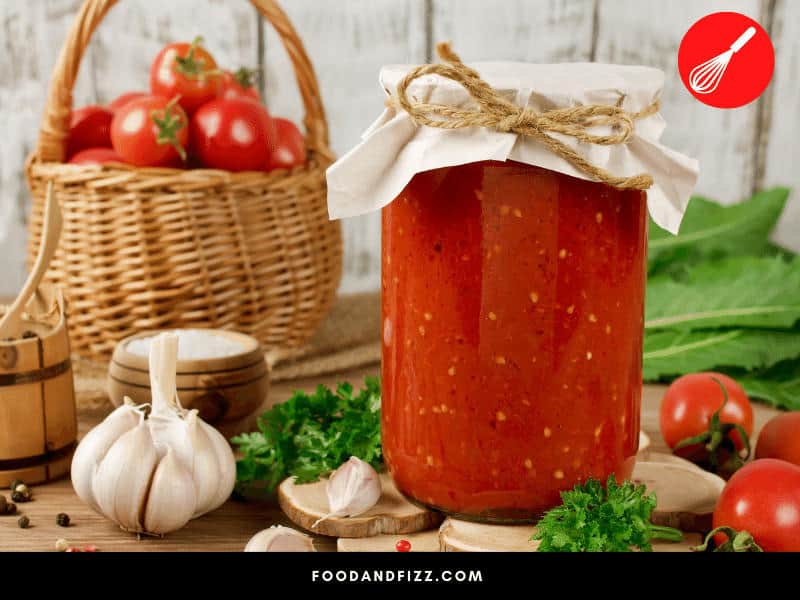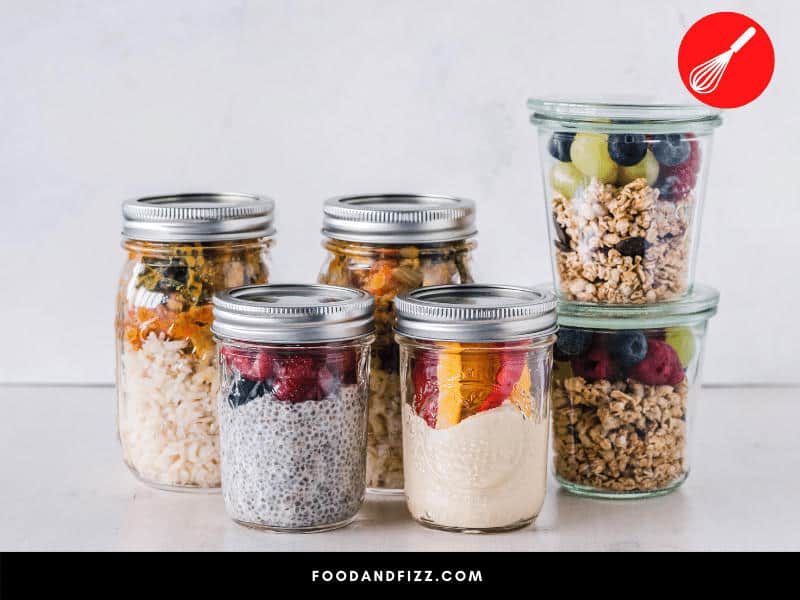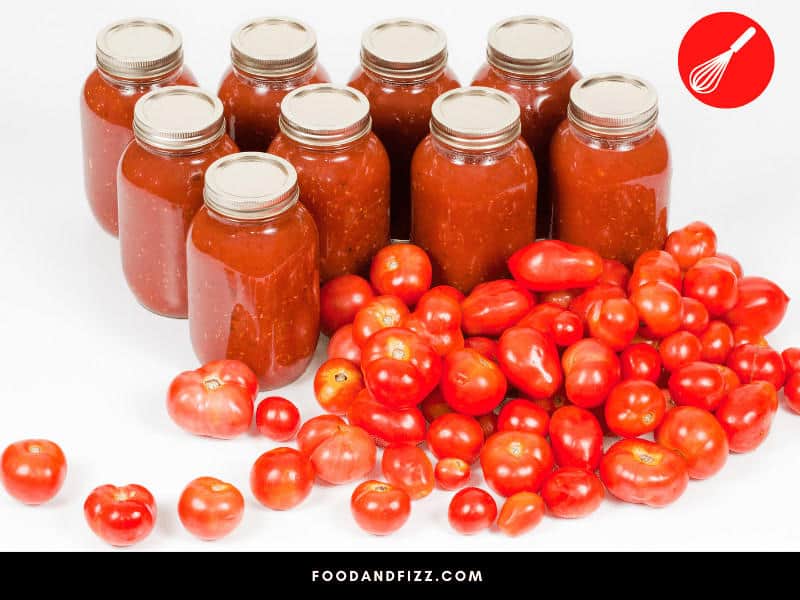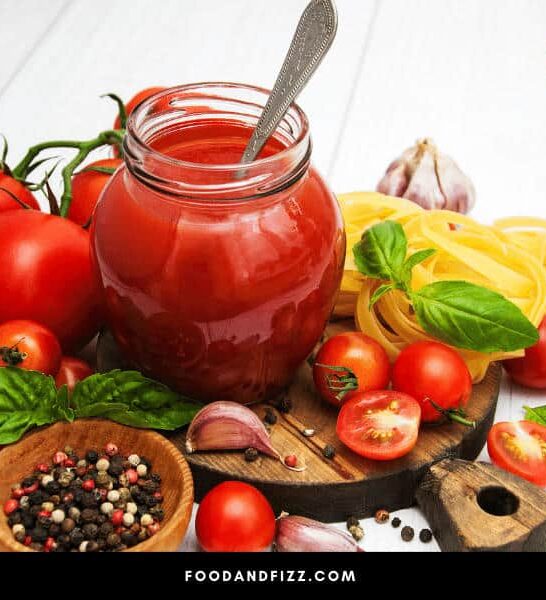If summer means garden tomatoes and homemade pasta sauce, you might be getting out the jars to put up home-cooked goodness for later in the year.
Or maybe you’re standing in the supermarket aisle wondering how much commercially jarred sauce you’ll need for the meal you’re contemplating. Read on to find out more about jars, home processing, and how many cups of sauce will fit in a jar.
How Many Cups In A Jar Of Pasta Sauce?
The amount of sauce in a jar depends on the size of the jar. A 16 oz. jar contains about 2 cups of sauce. A typical 32 oz. jar of commercial tomato sauce contains about 4 cups. This measure is approximate because the jar isn’t usually filled all the way to the top.

A Brief History of Home Canning
Though jars of sauce, jam, and pickled vegetables might seem like everyday items, they are a relatively recent culinary innovation. Of course, the use of ceramic and glass jars for food storage has existed for thousands of years. But these kinds of containers weren’t used for preserving food until the 1800s.
In ancient times, people used storage jars for all kinds of purposes. For example, Egyptian canopic jars were used during the mummification process to store the viscera of their owner for the afterlife.
Dried beans and grains stored in ceramic and glass jars as similar gifts for the dead have been found to still retain much of their nutritional content hundreds of years later.

Napoleon Bona-Jars?
When it comes to food storage, jars have usually been used for storing non-perishable foods, or packing them with preservatives like salt, sugar, vinegar, and alcohol.
But in 1795, Napoleon Bonaparte changed that. Seeking a way to provide, preserve and transport food for the French army, the French government offered 12,000 francs to anyone who could find a new means of storage.
Parisian chef, Nicolas Appert, discovered that food spoiled less rapidly in jars closed with cork, wire, wax, and boiling water. His process created a hermetic seal, pushing out the air and preventing the passage of oxygen and other gases into the jar.
Though it took 15 years for him to perfect his experiments, Appert won the 12,000 francs (and Napoleon lost at Waterloo).
Unfortunately, Appert’s method—and his choice of jars made of glass, as a material least penetrated by air—also made it impossible for gas to escape the jars. As in today’s home canning, this made for a safety risk, as the jars had a tendency to explode.
Mason Jars
By 1858, Appert’s method had been refined and improved. At that time, John Mason created the metal screw-top.
He soon followed this invention with the production of jars with threads that matched the screw-top metal cap, allowing for a tight fit with the rubber-sealed lid. In this way, the re-sealable Mason jar was born.
The Ball Corporation licensed Mason’s design in 1884, and Ball jars became a ubiquitous feature of home kitchens. The reusable, re-sealable jar allowed people to easily and economically store and preserve fruits and vegetables.

The First Commercially Jarred Pasta Sauce
While home cooks were already putting up pickles and sauces in the early 20th century, the Ragu company is typically credited with creating the first commercially jarred pasta sauce.
Begun by Italian immigrants in Rochester, NY in 1937, the depression-era mom-and-pop store became a national company over the next twenty years.
By 1969, the company was earning $22 million a year from a product that began with a family-operated home-canning machine.

Canning Methods
The method for storing food safely in a glass jar depends on the type of food being stored. Some foods can be safely stored using the water bath method, while others require pressure canning.
Water Bath Canning
High-acid foods like sauces made from fruit and vegetables (like tomato sauce) can be canned using the water bath method. Glass jars filled with sauce and tightly sealed with lids and caps are lowered into a pot of hot water.
Water is added to cover the jars and then brought to boil (212 degrees Fahrenheit or 100 degrees Celsius). Typically, at least ten minutes is required for the jars to expel the air and create a hermetic seal with the lid.
Pressure Canning
Low-acid foods like meats must be stored with the pressure canning method to prevent spoilage. Sealed jars are placed with a small amount of water in a pressure canner (similar to a pressure cooker).
The pressure typically increases the boiling steam to 240 degrees Fahrenheit (116 degrees Celsius), though the exact temperature required depends on the recipe and the food being stored. When the heat and pressure are reduced, the resulting low pressure inside the jar sucks the cap on more tightly.
In both cases, the changes in heat and pressure make it important to leave some space at the top of the jar to prevent overflow (or explosion!).
Additionally, any food or other substance that reaches the edges of the jar mouth or lid can cause contamination. For this reason, home and commercial canners don’t typically fill jars all the way.

Frequently Asked Questions to How Many Cups In A Jar of Pasta Sauce?
Why Are Mason Jars Good for Canning?
Glass jars are odor and stain-resistant. In North America, Mason jars have thicker walls than single-use commercial glass jars. This makes them a good choice for home cooks because they are less likely to accidentally break or explode.
How Do I Know If A Jar is Properly Sealed?
If a jar is properly sealed, then pressing down on the dimpled top of the lid will not make a sound. An improperly sealed jar will move up and down and sometimes make a popping noise.
How Much Sauce Does a Typical Mason Jar Hold?
Mason jars typically come in 8,16, and 32 oz sizes, though today they are made in other sizes, as well. The 16 oz (or one pint) Mason jar holds about two cups of sauce.

